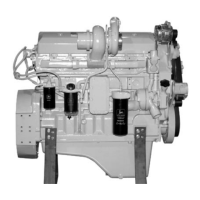Group 080
Air Intake and Exhaust System
02
080
1
RG,RG34710,1256 –19–23AUG02–1/2
Extending Turbocharger Life
Turbochargers are designed to last the life of the
engine, but because they operate at such high speeds
(100,000 rpm or more), a moment’s carelessness can
cause them to fail in seconds.
The major causes of turbocharger failures are
attributed to:
• Lack of lube oil (quick starts and hot shutdowns)
• Oil contamination
• Ingestion of foreign objects
• Restricted oil drainage
• Low oil level
• Operation on excessive side slopes
• Abnormally high exhaust temperatures
Lack of Lube Oil
Oil not only lubricates the turbocharger’s spinning shaft
and bearings, it also carries away heat. When oil flow
stops or is reduced, heat is immediately transferred
from the hot turbine wheel to the bearings, which are
also heating up because of the increased friction due
to the lack of oil. This combination causes the
turbocharger shaft temperature to increase rapidly.
If oil flow does not increase and the process continues,
bearings will fail. Once the bearings fail (which can
happen in just seconds), seals, shaft, turbine and
compressor wheels can also be damaged.
The principal causes of turbocharger bearing
lubrication problems are low oil pressure, a bent,
plugged or undersized oil lube supply line, plugged or
restricted oil galleries in the turbocharger, or improper
machine start-up and shutdown procedures.
Oil levels and pressure should always be closely
monitored and all worn hoses and lines should be
replaced. The turbocharger oil supply line should be
checked frequently to make sure it is not kinked or
bent, and it should always be replaced with a line of
equal size, length and strength.
The easiest way to damage a turbocharger is through
improper start-up and shutdown procedures. Always
idle the engine for at least 30 seconds (no load) after
start-up and before shutdown. Warming the engine up
before applying a load allows oil pressure to build up
and lines to fill with oil.
Idling the engine before shutdown allows the engine
and turbocharger to cool. “Hot” shutdowns can cause
the turbocharger to fail because, after high-speed
operation, the turbocharger will continue to rotate long
after the engine has been shut off and oil pressure has
dropped to zero. This will cause heat to build up and
possible bearing damage. It can also cause carbon
and varnish deposits to form.
Oil Contamination
A second cause of turbocharger failures is
contaminated oil. It can be caused by a worn or
damaged oil filter or not changing the lube oil at
recommended intervals. Expecting the oil filter to
remove dirt, sand, metal chips, etc., from the oil before
they reach the engine or turbocharger can be a costly
mistake because contaminated oil may completely
bypass the engine oil filter if the oil filter or oil cooler is
clogged, if the filter element is improperly installed, or
if the oil is thick during cold weather.
Four good ways of avoiding oil contamination are:
• Always inspect the engine thoroughly during major
overhaul. Look especially for any sludge or debris
left in lube oil galleries.
• Change lube oil at recommended intervals. Analysis
of oil samples at filter change periods can help
identify potentially harmful contaminants in the oil.
• Clean the area around the oil fill cap before adding
oil.
• Use a clean container when adding oil.
CTM100 (06APR04)
02-080-1
P
OWER
T
ECH
10.5 L & 12.5 L Diesel Engines
040604
PN=301
Continued on next page

